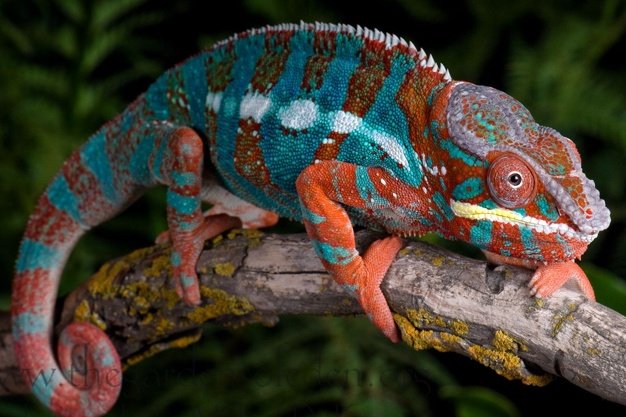2 Reasons Why Chameleon Changes their Colour?

Chameleons are colorful lizards also known as one of the few animals that can change skin color. However, it is a misconception that chameleons change colors to match their surroundings. Then how do they blend with any environment? What is the reason behind the color change? How do they change color? All these questions are answered here. First, let’s see what are these creatures?
What are Chameleons?
Chameleons or chamaeleons are a distinctive and highly specialized clade of Old World lizards.
The word chameleon is a interpreted from Latin and Greek word “chamaeleōn” means “on the ground” and “léōn” means “lion”.
Chameleon, belong to the family of Chamaeleonida, any of a group of originally arboreal (tree-dwelling) lizards. Chameleons are best recognized for their ability to change the body colour.
What are their Characteristics?
Characteristics of chameleons involve:
- It has feet in which two toes point forward, and two to the rear.
- It has the teeth joined to the edge of the jaw without sockets.
- Its eyes can rotate around in two different directions.
- It has glands which contain harmless trace amounts of venom, and a long, sticky projectile tongue.
Why they change their colour?
Temperature:
- A chameleon changes its colour to regulate its body temperature to that of the outside temperature.
- A cold chameleon will turn dark to absorb more heat, while a hot chameleon will turn lighter in shade in order to reflect the heat from its body.
Mood:
- The change in color in a chameleon can indicate its mood.
- An angry chameleon will have a darker color, whereas a chameleon in a relaxed mood will have a lighter color.
- A chameleon, upon seeing a rival, changes its color to darker shades in order to assert its dominance.
- On the other hand, a lighter color is used to attract potential mates.
Chameleons are often nearly impossible to see— And there’s a good reason for it: These are entirely defenseless. They don’t have a deadly bite, and they can’t move fast. Staying covered is much of their only tactic to avoid predators.
How they change colour?
Many of us think that a chameleon changes its colour to camouflage itself. However, this is one of the most common and false myths that people believe.
Chameleons have a unique type of cells in the body called chromatophores. They are able to manage these cells in order to change their color. A chameleon has two superimposed layers within its skin, and the upper layer consists of nanocrystals of different sizes. A chameleon changes its color by changing the size and shape of these nanocrystals.
- When a chameleon is in a relaxed state, the nanocrystals in the skin are closer to each other and they reflect shorter wavelengths, like blue and green.
- When a chameleon is excited, the distance between nanocrystals increases and it reflects longer wavelengths, such as red, orange and yellow.
Where do we see Chameleons?
- More than 150 species are currently recognized and furthermore continued to be named.
- About half of the species occur only in Madagascar whereas others occur mostly in sub-Saharan Africa.
- Two species occur in Asia; one is native to southern India and Sri Lanka, and the other is found from the Middle East to southern Spain.
Interesting Facts:
- Unlike many lizards, chameleons can’t regrow their tails.
- The chameleons’ eyes can twirl in two different directions and focus separately on 180-degree arcs.
- Chameleons real eyesight is great, they can see small insects 5-10 meters away.
- They can also see in both visible and ultraviolet light.
- Chameleons feed by projecting their tongues which is twice the length of their body to catch prey.
- Species of chameleon can be as small as 15 mm (0.59 in) or as large as 69 cm (27 in).
Get Free “Winspire Digital Worksheets of worth Rs. 129 Value”
Please enter your details to get the monthly E – Booklet + absolutely premium content to expand your horizons.


